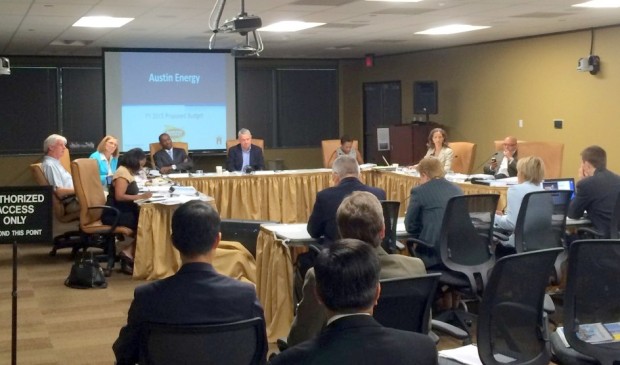City Council closing in on a final budget
Wednesday, August 20, 2014 by
Elizabeth Pagano City Council didn’t pull any punches at the start of Tuesday’s budget session, setting next year’s tax rate before anyone’s coffee had time to cool.
Council members voted unanimously to adopt the tax rate of 48.09 cents per $100 taxable value, which is in line with the budget proposed by City Manager Marc Ott. The rollback rate is 49.22 per $100 taxable value.
Council would have $11.9 million more in its budget had it adopted the rollback rate it, but because property values have risen so much over the past year, that may not have been an option it could have exercised without risking challenge.
Though budget talks are still in process, the vote means the city will not be able to exceed that rate, though it may ultimately decide on a lower one.
For the most part, talk continued to center on proposed rate hikes from the city’s utilities, as has been the pattern this budget session.
Council members took pains to clarify Austin Energy’s rate proposal, which they feared had been widely misunderstood.
Though the average Austin Energy customer will see a 2.6 percent increase in their energy bills, Mayor Lee Leffingwell called that an oversimplification.
Austin Energy CFO Ann Little explained that individual bills will differ from the affordability goals because the bills include fixed costs not included in the goal, which is calculated by dividing revenue by kilowatt hours. That translated to an overall revenue increase of 1.9 percent, which is within the 2 percent affordability goal.
It was clear that affordability goal, set during the recent rate changes at the utility, needed more fine-tuning down the road.
“There has to be an element of realism inserted into (the discussion),” said Council Member Laura Morrison. “It’s driven by the pass-through charges, which you can have a little control over … but if they go up high enough, theoretically, we would have to come back and lower our rates – there is a difference between our rates and charges – to keep under the 2 percent.”
“It’s not a simple policy discussion to have at all,” said Morrison.
On the other hand, though the Austin Water Utility has previously categorized its rate hike as an increase of 2.62 percent, Council members made it clear that, because of increased conservation, the increase was actually 12.1 percent.
In 2014, the average water customer used 8,000 gallons. In 2015 they are expected to use 7,000, and when the rates are adjusted to be “apples to apples,” the increase is just over 12 percent.
“You sell water by the gallon, right? So buying the same amount of water in 2015 costs you 12 percent more,” said Leffingwell.
“That’s a lot,” said Council Member Kathie Tovo.
Along with proposed rate hikes, the utility is also moving forward with the idea of “drought rates.” When the city is under Stage 3 restrictions, customers will pay a surcharge of $1 for every 1,000 gallons of water. Under Stage 4 restrictions, they will pay $3 for every 1,000 gallons.
AWU Assistant Director David Anders said they assumed under Stage 3 restrictions that water use would drop by about six billion gallons, or about $34 million dollars. That loss would be covered by the drought rate.
“In the long run, what has to be done is a more realistic customer charge to reflect the fixed costs that are involved, regardless of how much water is used,” said Leffingwell. “We don’t pay anything for water … What we don’t have is a system that reflects the true cost of the infrastructure required to provide the service. And, frankly, Austin Energy needs to do the same thing.”
Morrison pointed out they were starting to talk about customers paying for the service, not the volume.
“Last year, someone would be paying $45, and it doesn’t matter that they are using less. We still need the average person to be paying $45. That’s exactly what that rate increase … is recommending,” said Morrison.
Unlike the other rate hikes, the Watershed Protection Department’s proposed drainage fee increase had little to do with departmental operations. In fact, looking at the departmental highlights for the year, Morrison bestowed an imaginary title of “Department of the Year” and praised its work on keeping Barton Springs open for the next 20 years, rewriting the Watershed Protection Ordinance and orchestrating home buyouts in the wake of the Halloween Floods.
It’s that last item that is responsible for the proposed Drainage Fee hike, which would fund the remaining $78 million in buyouts. That will pay for buying an additional 240 homes in the Onion Creek floodplain and 72 homes in the Williamson Creek floodplain. Last week, City Council opted against funding those buyouts through a bond election.
You're a community leader
And we’re honored you look to us for serious, in-depth news. You know a strong community needs local and dedicated watchdog reporting. We’re here for you and that won’t change. Now will you take the powerful next step and support our nonprofit news organization?







